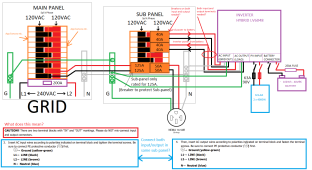LasseH
New Member
Hello and thanks for checking out my post.
I've never designed a solar system before, so hopefully none is gonna crush me in my newbie questions regarding the implementation.
I've been looking for examples of wiring, but most of the drawings online does not show the specific wiring schematic of inverters and how it is connected to the main breaker panel and the sub panel. There's a lot of video's of people showing off their finished wiring projects, but little to no images of their wiring schematic. So... I decided that I would give it a go. (please see image below for illustration)...
I decided to go with the MPP hybrid LV6048 using split phase connection. This is where I came across a lot of confusion.
I was wondering if this wiring looks ok? I fail to understand what the difference between input and output terminals are on this grid-tied/off-grid hybrid inverter, and I was hoping that some of you would be able to let me know if I'm on the right track?
1) Part of my concern relates to the fact that it states that "IN" and "OUT" markings should not be mis-connected. What does this mean?
2) Should both input and output be wired up with L1, L2, N and G?
3) Should they both have a 40A pole breaker?
Thanks!

I've never designed a solar system before, so hopefully none is gonna crush me in my newbie questions regarding the implementation.
I've been looking for examples of wiring, but most of the drawings online does not show the specific wiring schematic of inverters and how it is connected to the main breaker panel and the sub panel. There's a lot of video's of people showing off their finished wiring projects, but little to no images of their wiring schematic. So... I decided that I would give it a go. (please see image below for illustration)...
I decided to go with the MPP hybrid LV6048 using split phase connection. This is where I came across a lot of confusion.
I was wondering if this wiring looks ok? I fail to understand what the difference between input and output terminals are on this grid-tied/off-grid hybrid inverter, and I was hoping that some of you would be able to let me know if I'm on the right track?
1) Part of my concern relates to the fact that it states that "IN" and "OUT" markings should not be mis-connected. What does this mean?
2) Should both input and output be wired up with L1, L2, N and G?
3) Should they both have a 40A pole breaker?
Thanks!

Last edited:



